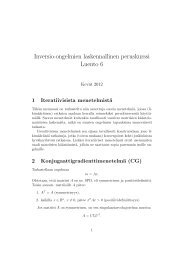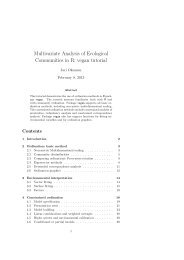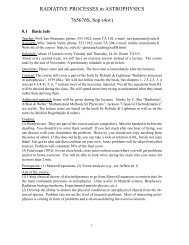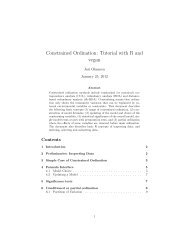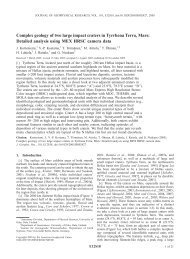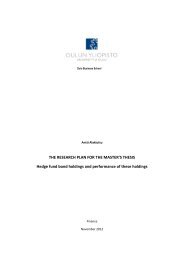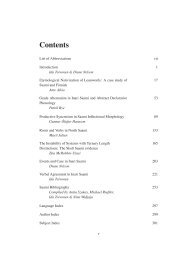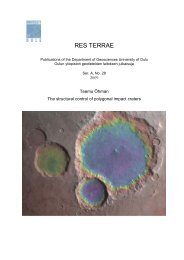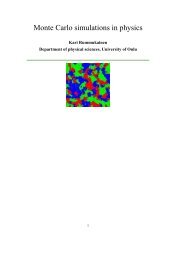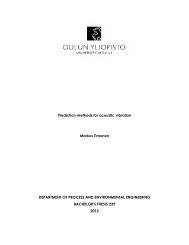Juha Köykkä - Oulu
Juha Köykkä - Oulu
Juha Köykkä - Oulu
- TAGS
- juha
- oulu
- cc.oulu.fi
You also want an ePaper? Increase the reach of your titles
YUMPU automatically turns print PDFs into web optimized ePapers that Google loves.
Res Terrae, Ser. A 32, J. <strong>Köykkä</strong>, Sedimentology of the Mesoproterozoic Telemark basin-fills, South Norway: implications for<br />
sedimentation processes, depositional environments and tectonic evolution<br />
settings are characterized by uniform sedimentation suites with thick, well-sorted<br />
sandstone successions, a lack of clear vertical trends, and a lack of mudstone (e.g.,<br />
Soegaard and Eriksson, 1985; Eriksson et al., 1998). It is thought that these tidal and<br />
nearshore environments during the Precambrian were generally high energy and were<br />
wider and shallower than their Phanerozoic counterparts (see Eriksson et al., 1998,<br />
2005; Eriksson and Simpson, 2004).<br />
The Brattefjell Formation is subdivided into three members based on its distinct li-<br />
thofacies assemblages (Fig. 4). As a whole, the Brattefjell Formation consist diagnos-<br />
tic criteria of an ancient tidal influence in a marine nearshore setting. These criteria are<br />
the following: (i) bi-polar sedimentary structures (herringbone); (ii) double mud<br />
drapes; (iii) sandstone foresets bounded by mudstone couplets or mudstone drapes and<br />
re-activation surfaces reflecting flood-ebb cycles; and (iv) alternations of successive<br />
thick and thin bundles reflecting a diurnal variation. Although tidal bundles in the an-<br />
cient rock record can be disturbed by later erosion, the bundle measurements suggest<br />
that at least 16–18 bundles were formed during the neap-spring cycle, which is sugges-<br />
tive of mixed semidiurnal tides. Paper III concludes that in the early stage of the lower<br />
Brattefjell member sedimentation, the regional subsidence caused marine conditions to<br />
cover wider areas, which gave rise to an early stage of transgression and a minor<br />
landward migration of the shoreline, forming shallowing upward stacking pattern<br />
cycles. The paper suggests that these cycles represent autogenic water level changes in<br />
a sedimentation basin caused by regional subsidence water level changes. The lithofa-<br />
cies assemblages are suggestive of subtidal settings, where tidal currents and wave ac-<br />
tions form complex combinations. The sedimentation at the early stage of the middle<br />
Brattefjell member was characterized mainly by tidal sand flats, tidal channels, sand-<br />
bars, and lagoon-estuarine developments likely protected by sandy barrier ridges. An<br />
ebb-dominant bedload transport was widespread over suspensions and sandbars, and<br />
reactivation surfaces were common. A rise of the relative base level during sedimenta-<br />
tion of the middle Brattefjell member deposited interlayered mudstone and sandstone<br />
beds, suggesting alternating deposition from suspension and traction currents. Suspen-<br />
sion settling occurred during tidal slacks, while traction characterized ebb and flood<br />
currents.<br />
54



